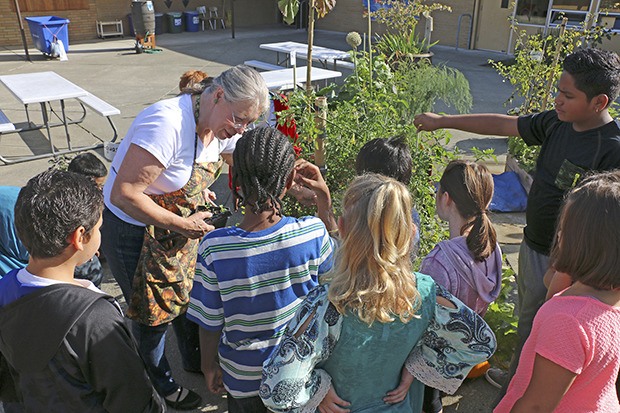The concrete courtyard at Lea Hill Elementary School could have looked drab that overcast day.
Carol Woodard had a different idea.
As students and staff pass through the central area of campus, they are surrounded by colorful beds full of beans, broccoli, corn, potatoes, pumpkins, strawberries, sweet peppers, tomatillos, zucchini and more.
While some educators move away from the classroom upon their retirement, Woodard has immersed herself in it.
Around the time she was set to retire –Woodard was a nurse for eight years at Lea Hill – principal Ed Herda said school officials were looking for ways to incorporate lessons from Eric Jensen’s book, “Teaching With Poverty in Mind: What Being Poor Does to Kids’ Brains and What Schools Can Do About It.” Herda said they broke into groups, and Woodard’s suggested school gardens because they “can be great for all kids.”
Woodard, 66, has experienced that for as long as she can remember. She described her parents as “Nebraska farm kids” in the 1920s and ’30s. During her own childhood, her family moved into a 100-by-100 foot corner lot. But the lack of space did not curtail her parents’ desire to grow: her father always had a large vegetable garden.
Now, Woodard is sharing those lessons with the youth at Lea Hill. She likes being able to work with students who live in apartments and do not have the opportunity to grow their own food.
Fourth-grade teacher Stephanie Beeksma said that applies to many of Lea Hill’s 450 students.
“A lot of kids don’t have gardens,” she said. “They are apartment dwellers. (The garden) expands their understanding of where food comes from.”
Team teaching
Woodard also collaborates with teachers to incorporate the garden into lessons. During one lunch in October, Woodard visited Beeksma’s classroom. Woodard told the students that four pounds of white potatoes were developed in the gardens and asked them to guess how many potatoes that equated to.
“Sometimes, in my garden, I have grown them as big as my foot,” said Woodard, who revealed the answer was 38 potatoes.
Woodard, who is known around the school as “The Vegetable Lady,” also asked students about different ways they eat potatoes. Most responded that they favor them baked.
Her goal is to incorporate the garden into classroom lessons in math, reading and science. Woodard also has worked with Lea Hill’s librarian to add a garden section.
And then explore the actual garden.
“It’s kind of a show-stopper,” Herda said. “Carol has everything labeled really nicely. It’s set up to be a great learning experience for our kids.”
Woodard said Herda has been supportive of the project since it began with about five beds and grew to house an estimated 50 varieties of plants. She said Herda told her there were some deeper, ornamental beds that could be cleared out to provide more space.
The upkeep, Woodard said, has become easier since a rain barrel was installed, which also defrayed watering expenses. Woodard visits Lea Hill three times during many weeks for various garden-related activities. She particularly is busy during the summer months when the plants must be pruned, watered and weeded. Woodard even brings compost from her sizable home garden to nurture the soil.
The sustainable garden is part of the reason why Lea Hill is a Level 4 Green School, the highest of rankings, in the King County Green Schools program.
In addition to lessons that apply to the classroom, Herda said the gardens have enabled students to become familiar with composting.
Projects also are prepared based on age and with an eye toward continuity. For example, fourth-grade students harvested the potatoes they planted the previous school year in October. Fifth-grade students enjoyed the 16 corn ears that were generated from a 4-by-4-foot patch.
Beeksma said she likes that Woodard attempts to use the same students, which gives them an understanding of the growing process “from beginning to end.”
“We’re really lucky to have her coming up here after she’s retired,” she said. “We really appreciate it.”
Younger students are involved as well. In the spring, Woodard said first- and second-graders plant radishes or onions with the idea that they “come up quick and they see them.”
For Woodard, who worked on and off in the district for 25 years, it is also a relaxing hobby to share with youths.
“It’s a little different stress than being a school nurse,” she said. “You don’t have to worry about colds, flus and people getting their shots. Gardening is another way to be healthy.”
And to create a scenic landscape for learning.



